Is it possible to live outside the city all year round: how to heat a summer house in winter, economically and efficiently?
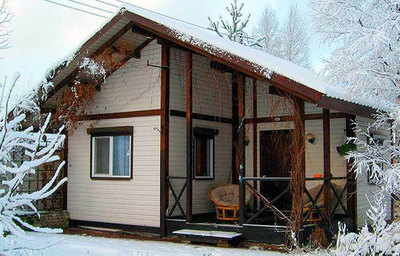
The more often a country house is visited, the more money goes to heating itWorking people come to their dachas on weekends, many pensioners live in their country houses all year round.
The right choice heating method allows you to save money funds allocated from the household budget for home improvement.
The choice of heater is influenced by region residence, age and condition of the building, accessibility of communications (gas networks and power lines), the ability to prepare or buy firewood, coal, liquid fuel.
Economical heating in winter
A warm house creates an atmosphere of comfort and tranquility, especially in winter and off-season. The following equipment is used to heat a summer house:
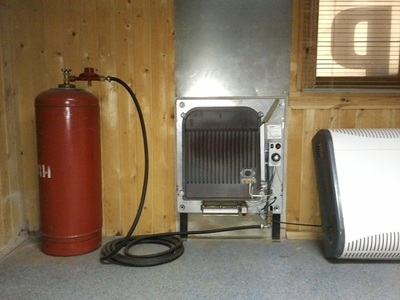
- gas boilers;
- gas cylinders;
- electric boilers;
- ovens potbelly stoves;
- metal stoves;
- liquid fuel, solid fuel and universal heating boilers.
Summer cottages are heated with portable electrical appliances (oil radiators, convectors, fan heaters).
In the absence of electricity and gas, you can use solar collectors.
Reference! Before purchasing a heating device, determine heat loss in the house, taking into account the area of the house, the presence of cold bridges in the structure. Based on the calculations, a heater is selected.
Gas boiler
Operating principle: using the built-in piezo devices the gas in the combustion chamber ignites, and the blower fan turns on. The heat exchanger heats up and gives its energy to the coolant. Hot water circulates in the heating system, heats the room and returns back.
Water heaters are divided into flowing (the water supplied by the water supply system is heated), and cumulative (water heating occurs in a pre-filled container).
Pros:
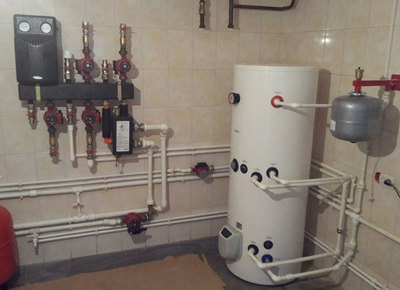
- fast heating heat carrier and water for domestic needs;
- absence harmful emissions, polluting the soil on the site;
- no time is wasted on fuel loading, its removal and disposal;
- low noise level during work.
Cons:
- necessity annual inspection, cleaning and diagnostics of equipment with the involvement of specialists;
- high costs for laying pipes from the main line to the house;
- high cost boiler, related equipment, gas tank;
- need for electric current to power the built-in pump;
- the need to install the boiler in in a separate ventilated room;
- high cost devices;
- high connection costs to the gas main; payment for the services of gas equipment specialists.
Saving:
- gas costs less, than for electricity, firewood, pallets and liquid fuel for heating;
- the cost is comparable to heated with medium quality coal.
Gas cylinders
Operating principle: after connecting the cylinder to the heating device, open the valve and gas flows to injectors heater. With the help of a piezo lighter, the gas ignites and gives off heat.
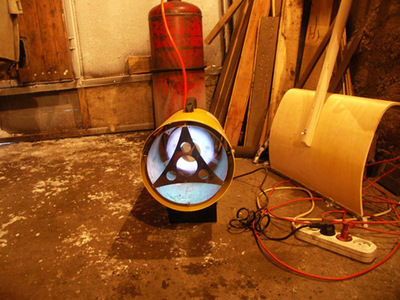
Heaters powered by gas cylinder:
- Heat gunsThe burning gas heats the air, which is forced into the room by an electric fan.
-
Gas ceramic heaters. The gas through the nozzles heats the ceramic screen, which creates infrared radiation. The sizes vary, they are made floor-standing and compact.
Stationary models are placed under the ceiling and on the walls.
- Gas catalytic heaters. The gas is fed to a screen made of fiberglass with platinum coating. Here the heat agent is oxidized, flameless combustion occurs, and thermal energy is generated.
- Gas stationary convectors. Through the nozzles, the hot gases heat the metal heat exchanger made of steel or cast iron. Air enters the convector through the lower slots, heats up and exits through the upper slots.
Attention! For wall-mounted convectors closed combustion chamber. Air for combustion is supplied from the street, and exhaust gases are also emitted outside.
Pros:
- Creation autonomous heating;
- ease of transportation;
- opportunity self-connection.

Photo 1. Gas convector model HS-8, power - 6.9 kW, manufacturer - "Hosseven", Türkiye.
Cons:
- fast gas consumption;
- necessity periodic refueling capacities at the enterprise that provides such services;
- big dimensions.
Saving:
- low cost gas and the portable gas holder itself;
- inexpensive replacement used cylinder to filled one;
- more profitable, than heating a summer house with electrical appliances.
How to heat a summer house economically using electricity
If the summer cottage village is electrified and there are no power outages, you can use electrical appliances. For small, rarely visited houses, fan heaters, convectors, infrared heaters, oil radiators are suitable. In a capital country house, owners install electric boilers.
Electric boiler
The principle of operation is heating heating elements or electrodes when an alternating electric current passes through them. The heating element gives off thermal energy to the heat exchanger, which heats the coolant. The coolant circulates through pipes and batteries, cools down and returns to the boiler. Water for domestic use is heated in a special tank.
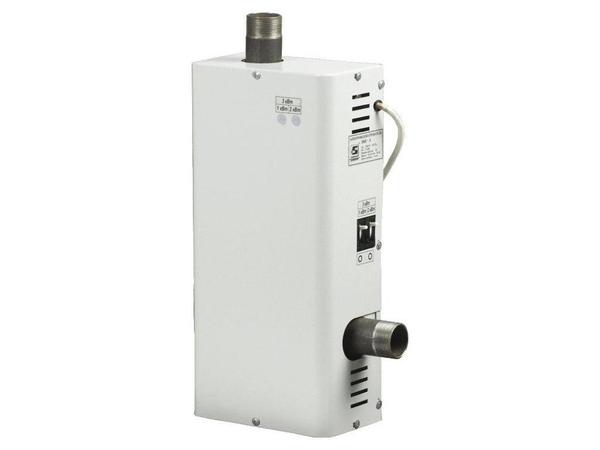
Photo 2. Electric boiler model EVP-3 with electronic control, power - 3 kW, manufacturer - Elvin, Russia.
Pros:
- reliability constructions;
- ease of management: changing modes is done using buttons on the front panel;
- the device does not need to be stopped for cleaning;
- no need to highlight technical room;
- heaters do not require constant supervision, and are automatically switched off in emergency situations;
- opportunity remote control via the Internet.
Cons:
- high cost dual-circuit models;
- big cost for electricity;
- increased demands on electrical wiring;
- for installation you need to involve specialists.
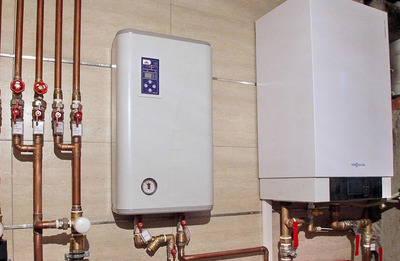
Saving:
- installation of electric boiler cheaper, than installation and adjustment of gas equipment and solar collector;
- If the summer cottage village is located in a treeless area where coal and firewood are expensive, then the use electricity will be profitable.
Furnaces
Heating a summer house with a stove is a traditional method of heating in winter. The size of the stove depends on the area of the house and the preferences of the owners. To heat small houses, use potbelly stoves, homemade and factory-made metal stoves.
Potbelly stove
Operating principle: combustion occurs in the combustion chamber solid fuel (wood, wood chips, coal), the fire heats the furnace body and the air in the room. single-chamber In furnaces, combustion products rush into the chimney and exit the house.
Heating with a potbelly stove channel type It heats the room better, since the fire follows the sections where the combustion products are burned out and the fuel is used more rationally.
Pros:
- simplicity exploitation;
- possibility of use any solid fuel;
- fast warm-up small room.
Cons:
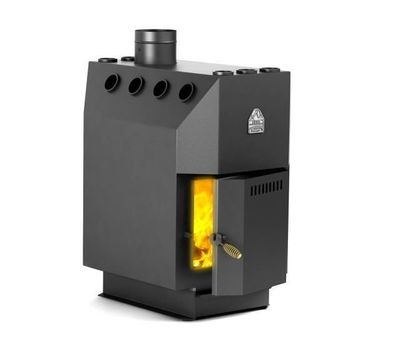
- the stove needs to be cleaned of ash almost daily;
- the stove takes up lots of space, it cannot be placed near walls that are not reinforced with heat-insulating materials;
- premises cools down quickly after the fuel has burned out.
Saving:
- low cost compared to a gas or electric boiler;
- the cost of making such a stove yourself 2-3 times lower, than buying;
- savings on electricity, gas and liquid fuel.
Metal stoves
Operating principle: metal stoves heat the room by burning solid fuel in the combustion chamber (firewood, pallets, coal, coke). The body of the stove quickly heats up and gives off heat. Such units are capable of heating the house within an hour, which distinguishes them from brick ovens.
Pros:
- possibility of use several types of solid fuel;
- simplicity assembly, installation and maintenance of the unit;
- metal heats up quickly and gives off heat well, which allows you to heat the house in the most severe frosts;
- opportunity independent buildings.
Cons:
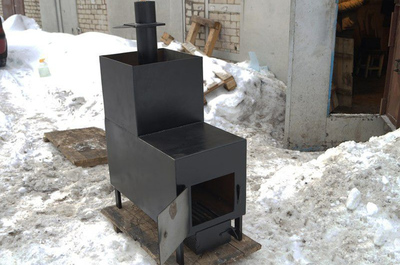
- premises cools down quickly after the fuel has burned out;
- Drops of water falling on the cast iron body causes it to cracking;
- have to periodically clean the ash pit and chimney.
Saving:
- low cost compared to a gas or electric boiler;
- savings on payment electricity, gas and liquid fuel;
- Suitable for burning any inexpensive solid fuel (including wood chips, brown coal, shavings, sawdust, dung).
Liquid fuel boilers
Operating principle: liquid fuel is fed into the burner, mixed with oxygen and ignited. In the combustion chamber, hydrocarbons oxidize and give off heat through a heat exchanger to the coolant, which circulates in the heating pipes and in the radiators. The flue gases are removed through the chimney.
Pros:
- Efficiency 95-98%.
- Service life tens of years without any serious breakdowns.
- Installation and adjustment does not require approval from regulatory authorities.
- Replacing the burners allows you to use several types of fuel.

Cons:
- for connection and initial adjustment it is necessary to involve specialist;
- the boiler is installed in a separate, non-residential area, since it makes noise;
- in the technical room for the unit it is necessary to do exhaust ventilation and a window.
Saving:
- low cost compared to a gas or electric boiler;
- allows to use both relatively expensive (diesel fuel), and cheap fuel (fuel oil).
Solid fuel devices
Operating principle: fuel is burned in the combustion chamber fuel and flue gases. High temperature heats the coolant, which circulates in the heat exchanger and the heating system of the cottage. The coolant heats the surrounding air, cools down and returns to the heat exchanger.
Pros:
- Possibility of use different types of fuel.
- Simplicity in operation.
Cons:
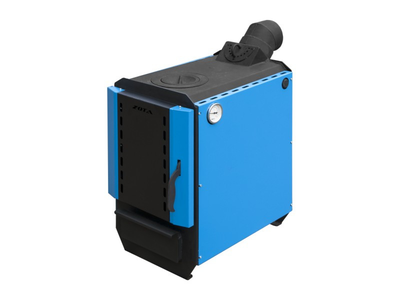
- Necessity daily maintenance (ash cleaning, fuel delivery).
- Fuel moisture content should not exceed 20%.
- Efficiency 75-80%.
Saving:
- costs cheaper gas;
- for installation and connection no permission required;
- allowed to burn any solid fuel.
Universal heating boilers
Operating principle: in the combustion chamber of the combined boiler, several methods of heating the coolant are used alternately. The modes are changed automatically or manually.
For example, the principle of operation of a boiler "gas - diesel fuel" "firewood - gas - diesel fuel" consists of alternately using diesel fuel, wood or gas. To do this, you need to install nozzles in the combustion chamber, connect the supply of liquid or gaseous substance, or fill the firebox with solid combustible material. When the unit is used to burn wood, the gas is turned off.
Pros:
- The design allows heating of the coolant in different ways, which increases safety during temporary power or gas outages.
- Equipped with control means and allow quickly replace one fuel with another.
Cons:
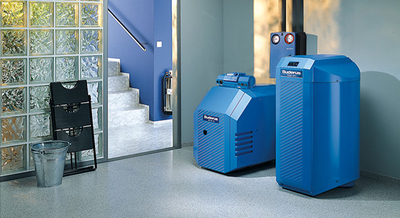
- high cost compared to conventional electric or gas boilers;
- to adjust the equipment it is required help from a specialist.
Saving:
- rational switching from one mode to another for saving expensive fuel, switching to cheap;
- The total savings could amount to a significant amount.
Useful video
Check out the video that talks about the different options for heating your summer house.
Is it possible to heat a country house cheaply?
Modern industry offers hundreds of models devices and systems for heating a summer house. The owner of a summer house needs to decide which of them will be the most effective and economical. To avoid unnecessary expenses, It is better to seek help from specialists in this area.









Comments